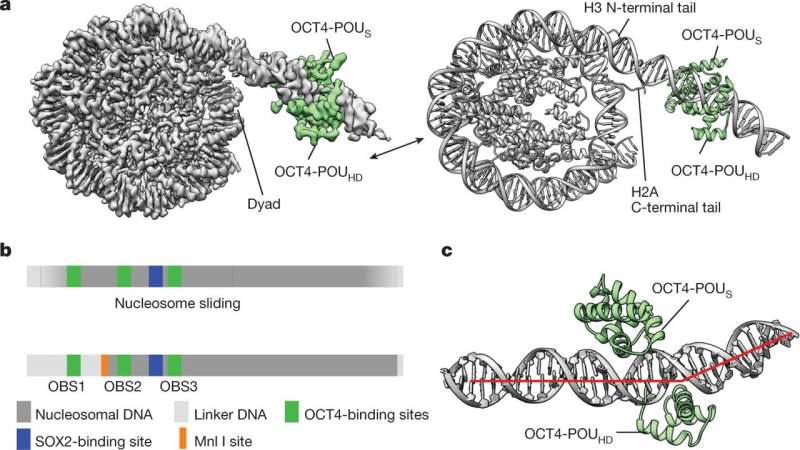This article has been reviewed according to Science X's editorial process and policies. Editors have highlighted the following attributes while ensuring the content's credibility:
fact-checked
peer-reviewed publication
trusted source
proofread
How the epigenetic landscape modulates pioneer transcription factor binding

Like thread tightly wrapped around a spool, DNA is wrapped around histones and packaged into structures called nucleosomes. Scientists at St. Jude Children's Research Hospital are exploring how a type of transcription factor called a pioneer transcription factor accesses DNA even when it is tightly wound. Their work revealed how the epigenetic landscape influences transcription factor binding.
Problems with transcription have been implicated in numerous cancers, so this more detailed understanding of the process may aid in developing future therapeutics. The study was published in Nature.
The nucleosome packaging of DNA can physically block transcription factors that regulate gene expression from accessing their binding sites. Restricting access to DNA is an integral part of how transcription is regulated. However, pioneer transcription factors can bind to their target piece of DNA even within compacted chromatin and are also known to promote the binding of other transcription factors.
Among pioneer transcription factors are the so-called Yamanaka factors which include Oct4 and are used to induce pluripotency (the ability to give rise to different cell types). How pioneer transcription factors access tightly wound DNA was unclear. To better understand the process, scientists at St. Jude used cryo-electron microscopy (cryo-EM) and biochemistry to investigate how Oct4 interacts with nucleosomes.
"Building on prior work to understand the dynamic behavior of nucleosomes, we wanted to understand how other factors might utilize those dynamic changes to access chromatin," said corresponding author Mario Halic, Ph.D., St. Jude Department of Structural Biology. "Oct4 did not bind where we anticipated it might—rather than binding inside the nucleosome, we found that it bound a little bit outside."
"One of the main findings is that epigenetic modifications can affect transcription factor binding and cooperativity," Halic added. "The existing epigenetic state of chromatin can determine how transcription factors will cooperatively bind to chromatin."
The epigenetic impact
Results show that the first Oct4 molecule binding "fixes" the nucleosome in a position that increases the exposure of other binding sites, thus promoting the binding of additional transcription factors and explaining transcription factor cooperativity. They also found that Oct4 contacts histones, and these interactions promote chromatin opening and influence cooperativity.
Their work also showed that modifications at histone H3K27 affect the positioning of DNA by Oct4. These findings explain how the epigenetic landscape can regulate Oct4 activity to ensure proper cell programming.
Notably, the researchers used endogenous human DNA sequences instead of artificial sequences to assemble their nucleosomes. This allowed them to study the dynamic nature of the nucleosome, despite it being more challenging to work with.
"In this work, we used real genomic DNA sequences to study transcription factors in the context of where they function," said first author Kalyan Sinha, Ph.D., St. Jude Department of Structural Biology.
"This strategy allowed us to discover that the first binding event of Oct4 positions the nucleosomal DNA in a manner that allows cooperative binding of additional Oct4 molecules to internal sites. In addition, we observed exciting interactions with histone tails and have seen that histone modifications can alter those interactions. Together, these findings provide new insights into the pioneering activity of Oct4."
"Histone modifications affect how DNA is positioned and how transcription factors can bind cooperatively," Sinha added, "which means in cells, if you have the same DNA sequence, different epigenetic modifications can result in different, combinatorial effects on transcription factor binding."
More information: Mario Halic, Histone modifications regulate pioneer transcription factor cooperativity, Nature (2023). DOI: 10.1038/s41586-023-06112-6. www.nature.com/articles/s41586-023-06112-6
Journal information: Nature
Provided by St. Jude Children's Research Hospital



















